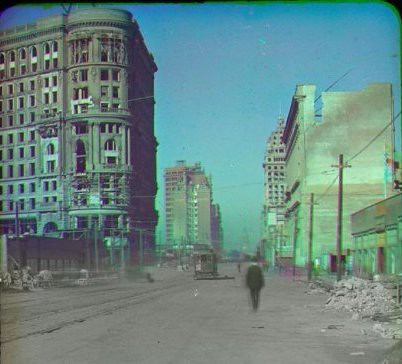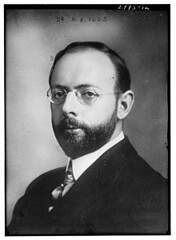
PREV ARTICLE
NEXT ARTICLE
FULL ISSUE
PREV FULL ISSUE
HERBERT IVES AND THE AMERICAN NUMISMATIC SOCIETYEarthquakes new and old are in the news this week. A few days before the devastating quakes in Japan, it was announced that the first known color photographs of San Francisco following the 1906 earthquake had been found. They are at once beautiful and eerie, especially in a world used to seeing that era through the lens of a black-and-white camera. No, kids, the world did not used to be in black-and-white, although that's an easy assumption to make.

The first numismatic connection I thought of was the San Francisco Mint, the only government structure to survive the quake. But alas, I did not find an image of the Mint among the discovered photos (there are only six of them). The photos were taken by a man named Frederick Ives, and Michael Bates asked Robert Hoge of the American Numismatic Society whether this might be the same Ives family connected with the ANS. Turns out, it is. Robert Hoge writes: Here is material on Herbert taken (with a few corrections and modifications) from the ANS website, at www.numismatics.org. As you are probably already well aware, the ANS is in the process of making some exciting upgrades to our data base offerings. This might help to highlight something of our approach. Within a few weeks people will probably be quite surprised by the ongoing improvements! Both Herbert and Frederick Ives were American geniuses who contributed immensely to modern civilization. These great achievements and a wonderful public spirit is are reflected in the splendid collections bequeathed to the American Numismatic Society. Many wealthy collectors disperse their holdings or set up their own private foundations to retain them. Only a few great souls place their coins and other materials in a context where they can be truly appreciated and accessed by all who share an interest.
Upon graduation, Ives held a series of positions in industrial research, but his greatest successes came during his tenure at Bell Laboratories, which he joined in 1919 after serving in the U.S. Army Signal Corps during World War I, where he did early work in aerial photography. It was during his years at Bell that Ives became known as one of the world's leading electron-optical physicists. His research accomplishments were numerous and resulted in:
During World War II he received the Medal for Merit â€" the nation's highest civilian honor â€" for his work on night-vision devices during that conflict. By the time of his retirement from Bell Labs in 1947, Ives had published more than 200 papers and secured more than 100 patents. Ives joined the ANS as an associate member in April 1924. By 1925, he had been elected a Fellow. In 1937, Ives was named a Patron of the ANS because of his gift to the Society of twenty-two medals awarded to his father for his scientific accomplishments. (An outstanding group of medals) Ives was first elected to the ANS Council in January 1934 and remained on the Council until his death in November 1953. While on the Council, Ives served on various committees including: Medals, European Coins, and Publications. He chaired the latter committee from 1947 until 1951 during which the Society launched its bibliographic publication, Numismatic Literature. Ives' numismatic interests focused on three types of gold: English nobles, Venetian ducats, and Florentine florins. He published three significant works on these subjects: Foreign Imitations of the English Noble, Numismatic Notes and Monographs, no 93, 1941. "The Design of Florentine Florins as an Aid to Their Dating," ANS Museum Notes, v. 5, 1952. The Venetian Gold Ducat and its Imitations, Numismatic Notes and Monographs, no. 128, 1954. The last work was edited and annotated by Philip Grierson and published posthumously, inasmuch as Ives had died on November 13, 1953. Upon his death, Ives bequeathed to the ANS his extensive collection of gold coins.
There is more information on the ANS site than I had room to include here, so please go there for more information. The image of Ives (circa 1923) is from Wikipedia.
-Editor
To read the complete article, see:
Color pics of San Francisco after '06 quake found
(news.yahoo.com/s/ap/20110310/ap_on_re_us/us_great_quake_in_color)
The Numismatic Bibliomania Society is a non-profit organization promoting numismatic literature. See our web site at coinbooks.org. To submit items for publication in The E-Sylum, write to the Editor at this address: whomren@gmail.com To subscribe go to: https://my.binhost.com/lists/listinfo/esylum All Rights Reserved. NBS Home Page Contact the NBS webmaster 
|
